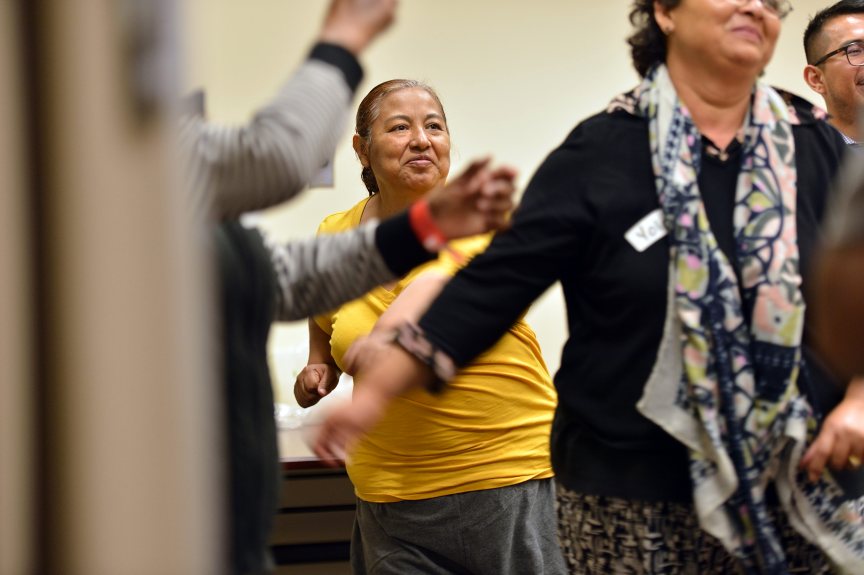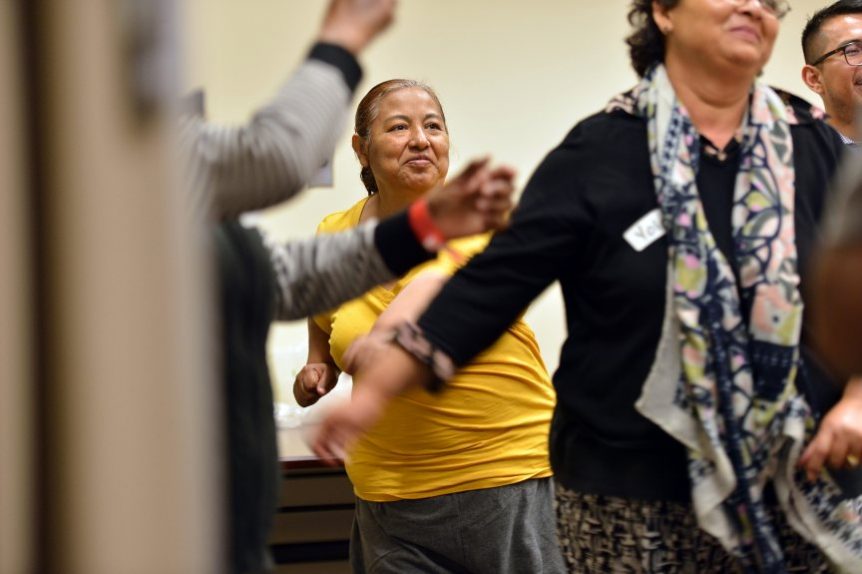SANTA ANA, CA| by Deepa Bharath | June 3, 2019
Original article can be found at: https://www.ocregister.com

When Gloria Huerta first walked into the weight-management clinic at the UCI Family Health Center in Santa Ana about six months ago, she was struggling with diabetes, depression and knee pain.
The 57-year-old homemaker, who does not have health insurance, said her doctor told her that unless she made a few lifestyle changes, she would need to take insulin for the rest of her life.
“I did not want to take insulin,” Huerta said. “I wanted to avoid it at all costs.”
So, she signed up for a weight-management class and started acupuncture for her left knee at the federally qualified health center, which in addition to traditional medicine offers preventive programs and alternative treatments.
Huerta is benefiting from a growing nationwide movement to broaden access to integrative medicine, particularly to underserved communities where chronic health conditions such as diabetes, obesity and high blood pressure are pervasive.
Huerta gets primary care and mental health services through this federally funded community clinic, which caters to the underserved. But now, she and others who lack health insurance have access to an entire suite of alternative care options and preventive health programs, which are generally reserved for the well-heeled.
About 20% of the Santa Ana clinic’s patients lack health insurance, and a majority of others are on Medi-Cal, said Dr. David Kilgore, a clinical faculty member at UCI Health who oversees the clinic’s programs.
He said the clinic and its programs are largely funded by grants from the Newport Beach-based Samueli Foundation, a philanthropic organization run by Henry and Susan Samueli. Henry Samueli is co-founder and board chairman of Broadcom Inc. and owner of the Anaheim Ducks ice hockey team.
Supportive group visits
Group medical visits offered to patients, including the weight-management class that Huerta attends, “are powerful vehicles to give people more time to learn and gain skills,” Kilgore said.
Group visits are a model of care in which up to 12 patients who have a shared condition such as diabetes or high blood pressure are seen together for an extended medical visit, allowing for individual attention, teaching time and even socialization.
On a recent Tuesday night, about a dozen participants in Huerta’s class discussed topics such as portion sizes and the importance of adding fiber to one’s diet.
Participants also occasionally get together at supermarkets with their instructors to learn how to shop for healthy foods and read nutrition labels. Two or three times a year, they watch local chefs demonstrate how to cook healthy meals.
Most important, Huerta said, the group has helped her make new friends.
“The empathy and support I get from this group has been amazing,” she said. “In (the past) 10 years, my depression was really bad, I lost 99% of my friends. I stay back after class to talk to people. We exchange weight-loss tips, ask the instructors questions.”
Huerta has lost about 60 pounds in less than six months, she said. And her A1C blood hemoglobin level is down from 11, an indicator of severe diabetes, to 7, which is considered normal. She also has attended a few meditation classes.
“Deep breathing has helped me deal with my anxiety issues,” Huerta said.
Making integrative medicine accessible
Integrative medicine is increasingly common in conventional health care settings. Nearly 38% of adults in the United States and about 12% of children use some form of alternative medicine, according to the National Institutes of Health.
Several federally qualified health centers in California and across the country are embracing group visits as a means of health education and offering integrative care.
Federally qualified health centers, which treat a large percentage of the uninsured, now offer group medical visits for a range of chronic conditions in 11 states, according to a survey published in April in the journal Health Equity.
“Group medical visits are an innovative model to improve access to non-drug approaches to caring for chronic illnesses,” said Maria Chao, associate professor at UC San Francisco’s Osher Center for Integrative Medicine, who co-authored the Health Equity study.
The survey asked 57 clinicians about how they use integrative care in health clinics serving low-income communities. Forty percent of those surveyed worked in federally qualified health centers.
Also, 37 out of 57 respondents in 11 states provided group medical visits. Nutrition, mindfulness, meditation, tai chi and yoga were the most common treatment approaches in these integrative programs, the survey showed.
Chao said the opioid crisis has prompted a number of health care clinics, including several in the Bay Area, to consider non-drug approaches such as acupuncture for pain management.
“Providers are happy to be able to broaden their toolbox and offer patients something other than a prescription,” she said. “Increasingly, we also find that patients want (non-drug) approaches. Integrative medicine can help with symptoms, intensity of pain and quality-of-life issues. Patients are able to reduce stress and sleep better.”
Notably, integrative medicine seems to improve “pain self-efficacy,” which refers to patients’ confidence that they can function well even if they are experiencing pain, Chao said.
Managing pain with acupuncture
Alternative treatments such as acupuncture can be expensive. While acupuncture is a covered benefit for Medi-Cal patients, those who are uninsured may have to pay anywhere from $75 to $150 for one acupuncture session. At the UCI clinic in Santa Ana, the first session is billed on a sliding scale, and subsequent sessions cost $2 each.
The clinic has been offering acupuncture on Fridays from 8 a.m. to noon since January 2016. The demand has been so overwhelming that patients have been wait-listed for the next four to five months, Kilgore said.
Felix Zuniga Medina, who is uninsured, said he lived with shoulder pain that was so bad he couldn’t lift his right arm.
“I couldn’t even pick up a dinner plate that was at a top shelf in my house,” said Medina, a 70-year-old car wash employee who became injured in a trip-and-fall accident about two years ago.
He took ibuprofen for a year, but the pain remained. Medina’s doctor at the clinic gave him the option of yoga or acupuncture.
“I work at the car wash seven hours a day or until my body gives up,” he said. “I didn’t have the energy for yoga. So, I decided to try acupuncture.”
After nine treatments, Medina said, his pain is completely gone. He wishes the clinic offered acupuncture on more days so more patients could benefit from it.
Kym Loi, the acupuncturist who treated Medina, said she sees a number of uninsured patients at the clinic. On Fridays, she treats up to 10 patients over a four-hour period.
Loi’s patients run the gamut — from those with aches and pains to people who have serious health conditions, including organ damage. On a recent Friday, she worked on Elma Garcia, 58, who is waiting for a liver transplant.
Garcia, who has Medi-Cal, was experiencing pain and a burning sensation in her back and had trouble breathing. Loi placed needles at strategic points in Garcia’s body to relieve pressure from her torso and back. A few minutes later, Garcia said her back felt better and she could breathe easier.
Long-term support
Kilgore said the clinic has also begun offering reiki, a healing technique based on the principle that a therapist can channel energy into the patient by means of touch to activate natural healing processes in the body and restore physical and emotional well-being.
“I cannot scientifically explain how reiki works,” Kilgore said. “But it does help people. I’ve seen patients who have been able to manage pain with fewer medications or go to sleep without drugs.”
By July, the clinic is also expected to get a fully equipped teaching kitchen where guest chefs can show patients how to prepare healthy meals. Eventually, the kitchen will have a “food pharmacy” that will distribute cooked, healthy food.
Kilgore said he views healthy food as medicine and healthy eating as a critical aspect of well-being. It’s not possible to provide meaningful health care to people and ignore their long-term well-being, he said.
“I cannot be a physician if I don’t address the root of why people are sick,” Kilgore said. “You have to help people connect with motivations for their health. Like, if you eat better you’ll have less pain and be able to play with your grandkids.”
The Uncovered California project results from an innovative reporting venture – the USC Center for Health Journalism News Collaborative – which involves print and broadcast outlets across California, all reporting together on the state’s uninsured. Outlets include newspapers from the McClatchy Corp., Gannett Co., Southern California News Group, and La Opinion, as well as broadcasters at Univision and Capital Public Radio.
Share this Post













